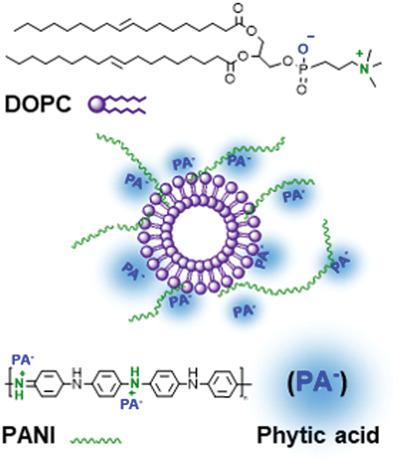当前位置:
X-MOL 学术
›
Macromol. Biosci.
›
论文详情
Our official English website, www.x-mol.net, welcomes your
feedback! (Note: you will need to create a separate account there.)
A One Step Procedure toward Conductive Suspensions of Liposome-Polyaniline Complexes.
Macromolecular Bioscience ( IF 4.4 ) Pub Date : 2020-06-15 , DOI: 10.1002/mabi.202000103 Minoo Eslami 1, 2 , Erica Zeglio 1, 2, 3 , Ghaida Alosaimi 1, 4 , Yihan Yan 1, 2 , Herleen Ruprai 5 , Alexander Macmillan 6 , Jan Seidel 1 , Antonio Lauto 5 , Habib Joukhdar 7 , Jelena Rnjak-Kovacina 7 , Damia Mawad 1, 2, 8
Macromolecular Bioscience ( IF 4.4 ) Pub Date : 2020-06-15 , DOI: 10.1002/mabi.202000103 Minoo Eslami 1, 2 , Erica Zeglio 1, 2, 3 , Ghaida Alosaimi 1, 4 , Yihan Yan 1, 2 , Herleen Ruprai 5 , Alexander Macmillan 6 , Jan Seidel 1 , Antonio Lauto 5 , Habib Joukhdar 7 , Jelena Rnjak-Kovacina 7 , Damia Mawad 1, 2, 8
Affiliation

|
Interaction of conjugated polymers with liposomes is an attractive approach that benefits from both systems’ characteristics such as electroactivity and enhanced interaction with cells. Conjugated polymer‐liposome complexes have been investigated for bioimaging, drug delivery, and photothermal therapy. Their fabrication has largely been achieved by multistep procedures that require first the synthesis and processing of the conjugated polymer. Here, a new one step fabrication approach is reported based on in situ polymerization of a conjugated monomer precursor around liposomes. Polyaniline (PANI) doped with phytic acid is synthesized via oxidative polymerization in the presence of 1,2‐dioleoyl‐sn‐glycero‐3‐phosphatidylcholine (DOPC) vesicles to produce a conductive aqueous suspension of Liposome‐PANI complexes. PANI interacts with liposomes without disrupting the bilayer as shown using differential scanning calorimetry and fluorescence quenching studies of the hydrophobic Nile red probe. The electronic conductivity of the Liposome‐PANI complexes, which stems from the doped PANI accessible on the liposome surface, is confirmed using conductive atomic force microscopy and electrochemical impedance spectroscopy. Further, short‐term in vitro cell studies show that the complexes colocalize with the cell membrane without reducing cell proliferation. This study presents a novel fabrication route to conductive suspensions of conjugated polymer‐liposome complexes suitable for potential applications at the biointerface.
中文翻译:

脂质体-聚苯胺复合物导电悬浮的一步法。
共轭聚合物与脂质体的相互作用是一种有吸引力的方法,它受益于两种系统的特性,例如电活性和增强的与细胞的相互作用。共轭聚合物-脂质体复合物已被研究用于生物成像、药物递送和光热疗法。它们的制造主要是通过多步程序实现的,这些程序首先需要合成和加工共轭聚合物。在这里,报道了一种新的一步制造方法,该方法基于脂质体周围共轭单体前体的原位聚合。在 1,2-二油酰-sn-甘油-3-磷脂酰胆碱 (DOPC) 囊泡存在下,通过氧化聚合合成植酸掺杂的聚苯胺 (PANI),以产生脂质体-PANI 复合物的导电水性悬浮液。PANI 与脂质体相互作用而不破坏双层,如使用疏水尼罗红探针的差示扫描量热法和荧光猝灭研究所示。使用导电原子力显微镜和电化学阻抗谱证实了脂质体-PANI 复合物的电子电导率,该复合物源于脂质体表面上可接近的掺杂 PANI。此外,短期体外细胞研究表明,复合物与细胞膜共定位,而不会减少细胞增殖。本研究为共轭聚合物-脂质体复合物的导电悬浮液提供了一种新的制备途径,适用于生物界面的潜在应用。使用导电原子力显微镜和电化学阻抗谱证实了脂质体-PANI 复合物的电子电导率,该复合物源于脂质体表面上可接近的掺杂 PANI。此外,短期体外细胞研究表明,复合物与细胞膜共定位,而不会减少细胞增殖。本研究为共轭聚合物-脂质体复合物的导电悬浮液提供了一种新的制备途径,适用于生物界面的潜在应用。使用导电原子力显微镜和电化学阻抗谱证实了脂质体-PANI 复合物的电子电导率,该复合物源于脂质体表面上可接近的掺杂 PANI。此外,短期体外细胞研究表明,复合物与细胞膜共定位,而不会减少细胞增殖。本研究为共轭聚合物-脂质体复合物的导电悬浮液提供了一种新的制备途径,适用于生物界面的潜在应用。短期体外细胞研究表明,复合物与细胞膜共定位,而不会减少细胞增殖。本研究为共轭聚合物-脂质体复合物的导电悬浮液提供了一种新的制备途径,适用于生物界面的潜在应用。短期体外细胞研究表明,复合物与细胞膜共定位,而不会减少细胞增殖。本研究为共轭聚合物-脂质体复合物的导电悬浮液提供了一种新的制备途径,适用于生物界面的潜在应用。
更新日期:2020-06-15
中文翻译:

脂质体-聚苯胺复合物导电悬浮的一步法。
共轭聚合物与脂质体的相互作用是一种有吸引力的方法,它受益于两种系统的特性,例如电活性和增强的与细胞的相互作用。共轭聚合物-脂质体复合物已被研究用于生物成像、药物递送和光热疗法。它们的制造主要是通过多步程序实现的,这些程序首先需要合成和加工共轭聚合物。在这里,报道了一种新的一步制造方法,该方法基于脂质体周围共轭单体前体的原位聚合。在 1,2-二油酰-sn-甘油-3-磷脂酰胆碱 (DOPC) 囊泡存在下,通过氧化聚合合成植酸掺杂的聚苯胺 (PANI),以产生脂质体-PANI 复合物的导电水性悬浮液。PANI 与脂质体相互作用而不破坏双层,如使用疏水尼罗红探针的差示扫描量热法和荧光猝灭研究所示。使用导电原子力显微镜和电化学阻抗谱证实了脂质体-PANI 复合物的电子电导率,该复合物源于脂质体表面上可接近的掺杂 PANI。此外,短期体外细胞研究表明,复合物与细胞膜共定位,而不会减少细胞增殖。本研究为共轭聚合物-脂质体复合物的导电悬浮液提供了一种新的制备途径,适用于生物界面的潜在应用。使用导电原子力显微镜和电化学阻抗谱证实了脂质体-PANI 复合物的电子电导率,该复合物源于脂质体表面上可接近的掺杂 PANI。此外,短期体外细胞研究表明,复合物与细胞膜共定位,而不会减少细胞增殖。本研究为共轭聚合物-脂质体复合物的导电悬浮液提供了一种新的制备途径,适用于生物界面的潜在应用。使用导电原子力显微镜和电化学阻抗谱证实了脂质体-PANI 复合物的电子电导率,该复合物源于脂质体表面上可接近的掺杂 PANI。此外,短期体外细胞研究表明,复合物与细胞膜共定位,而不会减少细胞增殖。本研究为共轭聚合物-脂质体复合物的导电悬浮液提供了一种新的制备途径,适用于生物界面的潜在应用。短期体外细胞研究表明,复合物与细胞膜共定位,而不会减少细胞增殖。本研究为共轭聚合物-脂质体复合物的导电悬浮液提供了一种新的制备途径,适用于生物界面的潜在应用。短期体外细胞研究表明,复合物与细胞膜共定位,而不会减少细胞增殖。本研究为共轭聚合物-脂质体复合物的导电悬浮液提供了一种新的制备途径,适用于生物界面的潜在应用。











































 京公网安备 11010802027423号
京公网安备 11010802027423号